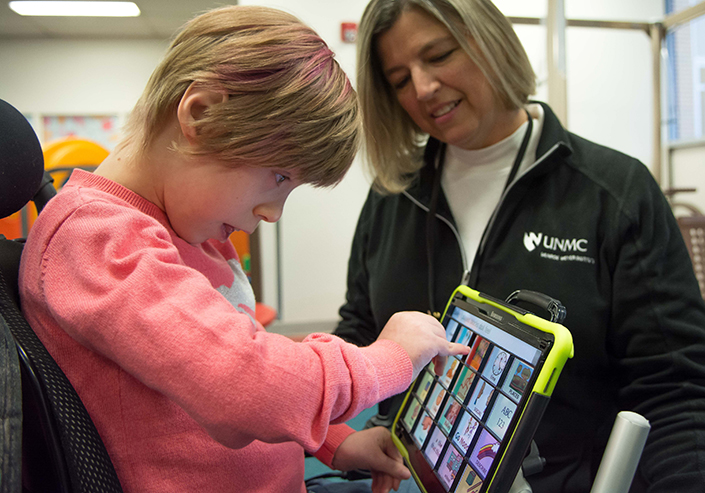What is Assistive Technology?
Assistive technology is an umbrella term that describes any device, piece of equipment, software program or product system that is used by an individual with a disability to increase, maintain or improve their ability to interact with their environment in a meaningful way. Assistive technology can help individuals who have difficulty speaking, writing/typing, pointing, seeing, hearing, learning, remembering, walking, etc. An individual’s assistive technology needs will depend on their disability.

How can MMI help?
Home Modification
Physical and occupational therapists can come to your home to evaluate your accessibility concerns and problem solve with you about potential environmental modifications or equipment needed to support safe caregiving and promote independence. Therapists work closely with you and the durable medical equipment (DME) vendor you choose throughout this process. Some options include:
-
- General home accessibility: entrances, primary living spaces, doorways, stairways
- Bathroom accessibility: transfer safety, environmental supports & modifications
- Bedroom accessibility: specialized beds, bedrails, transfer assist equipment
Activities of Daily Living (ADL) and Instrumental Activities of Daily Living (IADL)
Basic self-care activities such as feeding, dressing, grooming, bathing, and toileting are considered ADLs. These activities, typically mastered in early childhood, can pose significant challenges to individuals with disabilities and their caregivers. Cooking, driving, using the telephone or computer, shopping, and managing medication are examples of IADLs, which are those tasks that support an independent lifestyle. Occupational therapists can help caregivers and individuals with disabilities problem solve barriers to independence in any of these areas, and offer task adaptations and/or equipment that supports independence and/or simplifies caregiving. Some supports include:
-
- Fine motor skills: writing aides, adapted materials / tools
- Dressing, grooming, and/or bathing aides
- Adaptive utensils, dishes, and/or cookware to support meal preparation and/or participation
Augmentative and Alternative Communication (AAC) Evaluation
Individuals who are unable to speak due to severe speech and language disorders benefit from an augmentative and alternative communication (AAC) evaluation with a speech-language pathologist to assess their communication needs and identify an effective and efficient means of communication using low-tech or high-tech tools. These tools can help an individual actively participate in their daily routine or become an independent communicator. The following are examples of various types of communication equipment that may be considered in an AAC evaluation:
-
- Low-tech communication boards or books
- Speech generating devices
- Alternative access (e.g., switch, key guard, head trackers, eye gaze, etc.)
- Wheelchair mounts
Individuals who struggle to access a computer and other methods of communication, such as e-mailing or texting, benefit from an evaluation by a speech-language pathologist and/or an occupational therapist to identify technology that helps individuals independently access a computer and/or phone. These tools may also be utilized to control smart devices in the home (e.g., tv, lights, doors, etc.). Some examples of equipment include:
-
- Adapted mouse
- Head trackers
- Eye trackers
- Voice activated devices
- Smart home peripherals

